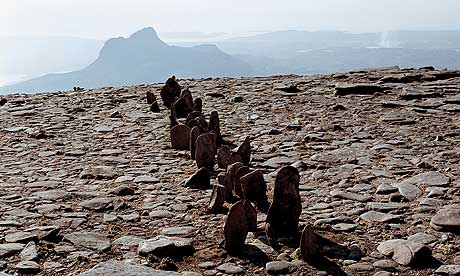
There are many beautiful areas in Ireland, but I'm particularly fond of Connemara. It's quite a place, what with the lakes, the sharply indented coastline, the rich pattern of muted hues that constitute the bogs, and the ubiquitous presence of stone. Stone is everywhere, be it the granite boulders carefully mortised into the drystone walls that are characteristic of most of the west of Ireland, the green marble souvenirs sold in the numerous craft shops in the area or the glinting silicate tips of the Twelve Bens mountain range. You just can't escape the thought of rock. Why would you want to?
I suppose that many readers of poetry will now be thinking of Yeats's "Fisherman" who went "To a gray place on a hill/In gray Connemara clothes" – clothes the colour of the rock that juts out here and there – or Robert Frost's "Mending Wall", a poem that could well have been written by a Galway farmer. These two poems reflect the two poles of the role of stone in human culture: on the one hand, stone is the bedrock on which our world rests; on the other it becomes an artefact and indicator of civilisation.
Gary Snyder's "Riprap" inhabits a similar world to "Mending Wall". Once again, stones are used to make a human mark on the natural world. There is something provisional about this arrangement of small rocks to make a forest trail that reminds me of Richard Long's sculptures; despite their apparent solidity, there is something impermanent about these structures that makes their beauty even more startling.
It isn't often that you come across a poet who is also a professional stoneworker; in fact, I think Bob Arnold is the only one I know of. His poem "Rhythm" is a clear statement of the pleasure of handling rock when he writes "It isn't confusing/It's stone".
There is a kind of Gothic romance to be found in stone ruins, many poets have been inspired to write about them. Frequently such poems are variants on a "this too shall pass" memento mori theme. Not so "The Sheep in the Ruins" by Archibald MacLeish. In this poem the transforming power of human imagination can bring the ruins back to life and recreate the world they represent.
Perhaps the lure of romantic gloom is harder to resist when the stones are ancient megaliths with supposed Druidical connections. Certainly Thomas Hardy made no attempt to lighten the gloom in his "The Shadow on the Stone", a poem that reads like it could easily be the lyrics for a dirge by some up-and-coming emo band.
Robinson Jeffers, in a poem called "Oh Lovely Rock", prefers to focus on stone's permanence and endurance and its ability to seem to be, in its own slow way, a living thing. This is an attitude that finds its ultimate expression in what is probably my favourite rock poem of all, "On a Raised Beach" by Hugh MacDiarmid. This is a long poem and is not fully available on the internet, but you can read an extract here. At the poem's core are the lines "We must reconcile ourselves to the stones,/Not the stones to us", a simple but elegant statement of the central ecological dilemma of our time in a poem that was written long before these matters became fashionable.
And so, this month's invitation is to write a rock poem. Whether your stones are found in nature or hewn by human hands, be they great slabs of bedrock or tiny pebbles, the challenge is to turn them to song. Get carving.

